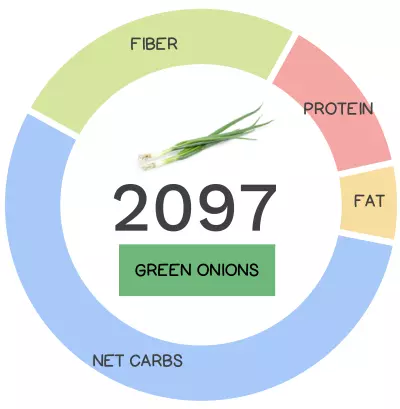
Nothing adds more flavor to dishes than onions, which are grown all around the world because of their diversity and unique taste. This veggie comes in a wide range of shapes and colors, ranging from numerous shades of green to brown, yellow, white, red and deep purple. The options seem limitless. In fact, onions (Allium cepa) are the widest-cultivated member of the Allium family (also known as the onion family!), which includes over 900 different species, although the ones we’re most likely to see on a dinner plate are garlic, leeks, chives, scallions, and shallots. The word “onion” is derived from the Latin word ‘unio’ which means ‘single or one’ because the onion plant produces a single bulb and the word “allium” is believed to derive from the Greek ἀλέω (or aleo), which means “avoid,” and refers to the potent odor of these vegetables! (Indeed, alliums contain an enzyme called alliinase that produces volatile sulfur compounds when their plant tissue gets damaged, leading to their characteristic aroma and taste. These compounds also help keep the plants safe from pests!)
Onions are members of the allium family, and are closely related to chives, garlic, leeks, scallions, and shallots.
Historically, the geographic origin of onion is uncertain, though domestication likely took place in Southwest or Central Asia. Onions have been a part of the human diet since the Bronze Age (archaeologists have found traces of them in settlements dating back to 5,000 BC!), and ever since then, they’ve played an important role in various cultures. For instance, Ancient Greeks used to eat pounds of onions in preparation for Olympic competitions, and Ancient Egyptians considered onions to symbolize eternity, due to their concentric rings and spherical shape (onions were even buried alongside Pharaohs in their tombs; King Ramses IV was even entombed with onions in his eye sockets!). Since onions are so easily grown and stored, they were a staple food in their native lands for many years; one example is that workers who built the Egyptian pyramids seem to have lived off of stipends of radishes and onions. Onions were not only consumed as food but were also part of religious practices and were traditionally used in the treatment of various ailments. By the Middle Ages onions were one of the fundamental ingredients in many cuisines in most parts of the world. They were brought to North America by the first European settlers, only to discover the plant already in wide use by Native Americans!
By the Middle Ages onions were one of the fundamental ingredients in many cuisines in most parts of the world.
Although this veggie is considered to be among the oldest known vegetables, it is still widely popular. Today it is the third most essential crop after potato and tomato and is grown commercially in more than 170 countries. In the US, Americans consume an average of 20 pounds of onions per year – making them one of the top 3 best selling fresh veggies in this country!
Green onions and scallions look the same and tend to be used interchangeably in the kitchen. Most people would consider them to be the same thing, however, there is a technical difference. Scallions (Allium fistulosum) come from a species of onion that does not form bulbs, while green onions either come from onion varieties that do not form bulbs or are harvested very young from regular onions that would eventually form bulbs if left to grow. Now you know!
Learn What Foods to *ADD* to Your Diet
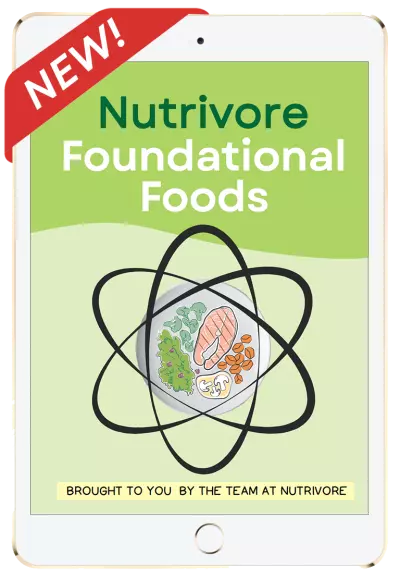
Nutrivore Foundational Foods
Learn what makes the 12 Nutrivore foundational food families nutritionally unique, their health benefits, which options are the most nutrient dense, how much of them to eat, plus various fun facts, practical pointers, and busting of common myths.
This very helpful resource will introduce you to new foods and expand your nutrition knowledge, making food choices easier!
Buy now for instant digital access.
Nutrivore Score for Green Onions – 2097
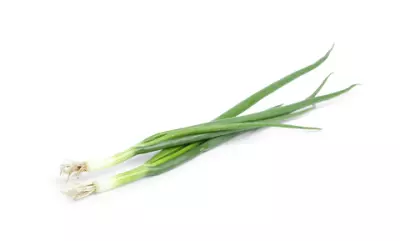
Green onions have a Nutrivore Score of 2097, making them a super nutrient-dense food! Plus, they are a low-carb and low-calorie-density food; the calorie count of green onions is 20 calories per cup!
Per serving, green onions are an excellent source (20-50% daily value) of thiosulfinates and vitamin K.
Ditch Diets. Embrace Nutrients. Start with These 5 Free Guides.
Sign up for the free weekly Nutrivore Newsletter and get 5 high-value downloads—delivered straight to your inbox—that make healthy eating simple and sustainable.
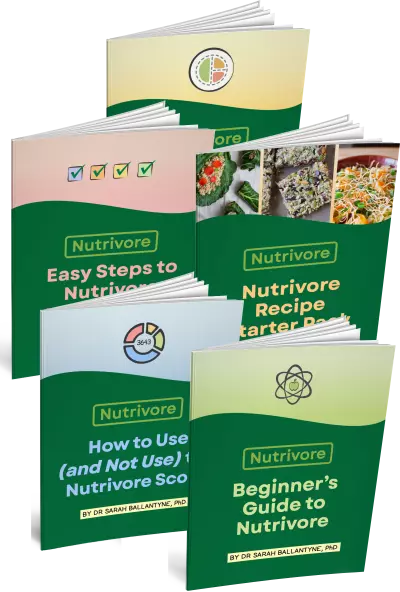
Green Onion Nutrition Facts
One serving of green onions is standardized to 1/4 cup or about 18 grams (0.6 ounces). A typical green onion stalk weighs 12 grams, which means: one serving of green onion is roughly equivalent to 1 1/2 stalks of green onion.
Green Onion Nutrition Facts Per Serving
| Green onions, raw | Nutrivore Score: 2097 | Nutrient Density: Super |
|---|---|---|
| Serving Size: 1/4 cup (17.75 grams) | Protein: 0.2 grams | Net Carbohydrates: 0.7 grams |
| Calories: 5 | Total Fat: 0.1 grams | Dietary Fiber: 0.3 grams |
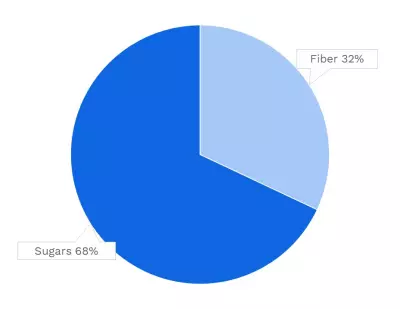


| VITAMINS | ||
|---|---|---|
| Vitamin A | 35.5 μg RAE | 4% DV |
| Vitamin B1 (Thiamin) | 5.3 μg | 0% DV |
| Vitamin B2 (Riboflavin) | 4.6 μg | 0% DV |
| Vitamin B3 (Niacin) | 0.1 mg | 0% DV |
| Vitamin B5 (Pantothenic Acid) | 0.0 mg | 0% DV |
| Vitamin B6 (Pyridoxine) | 15.6 μg | 1% DV |
| Vitamin B7 (Biotin) | 0.2 μg | 1% DV |
| Vitamin B9 (Folate) | 5.3 μg | 1% DV |
| Vitamin B12 (Cobalamin) | 0.0 μg | 0% DV |
| Vitamin C | 2.4 mg | 3% DV |
| Vitamin D (D2 + D3) | 0.0 μg | 0% DV |
| Vitamin E | 0.0 mg | 0% DV |
| Vitamin K | 27.7 μg | 23% DV |
| Choline | 0.8 mg | 0% DV |
| Myo-Inositol | 4.8 mg | ~ |
| CoQ10 | ~ | ~ |
| FUNCTIONAL FATS | ||
|---|---|---|
| MUFA | 0.0 g | 0% DV |
| ALA | 7.1 mg | 0% DV |
| EPA + DHA | 0.0 mg | 0% DV |
| CLA | 0.0 mg | ~ |
| Linoleic Acid | 0.0 g | 0% DV |
| MCT’s | 0.0 g | ~ |
| MINERALS | ||
|---|---|---|
| Calcium | 9.2 mg | 1% DV |
| Copper | 5.5 μg | 1% DV |
| Iodine | ~ | ~ |
| Iron | 0.1 mg | 1% DV |
| Magnesium | 2.8 mg | 1% DV |
| Manganese | 26.6 μg | 1% DV |
| Phosphorus | 4.4 mg | 0% DV |
| Potassium | 28.2 mg | 1% DV |
| Selenium | 0.1 μg | 0% DV |
| Sodium | 2.7 mg | 0% DV |
| Zinc | 0.0 mg | 0% DV |
| PHYTONUTRIENTS | ||
|---|---|---|
| Carotenoids | 578.3 μg | ~ |
| Polyphenols | 32.7 mg | ~ |
| Phytosterols | 3.9 mg | ~ |
| Glucosinolates | ~ | ~ |
| Thiosulfinates | 5.8 mg | ~ |
| Betalains | ~ | ~ |
| AMINO ACIDS & PEPTIDES | ||
|---|---|---|
| Taurine | ~ | ~ |
| Ergothioneine | ~ | ~ |
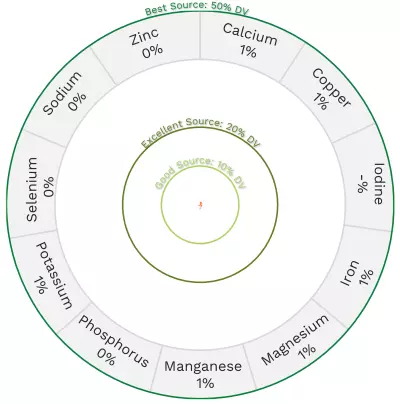

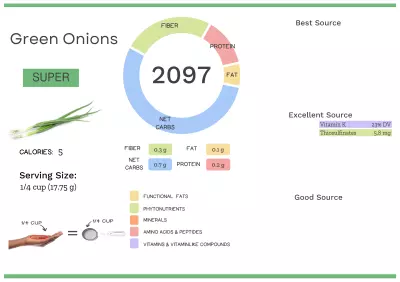
Onion Nutrition Varies With Variety
There are numerous varieties of onions differing in color (brown, green, red/purple, white, and yellow), shape, flavor, and phytonutrient content which means their Nutrivore Scores also vary. Including as many of these varieties as we can in our diet is a great way to maximize all the benefits onions have to offer.
| NUTRIVORE SCORE | |
|---|---|
| Green onions, raw | 2097 |
| Onions, raw | 380 |
| Scallions or spring onions (includes tops and bulbs), raw | 1932 |
| Sweet onions, raw | 1701 |
| Welsh onions | 1704 |
Does all the nutrition in green onions have you crying tears of joy? Maybe your friends will too!
Health Benefits of Green Onion Nutrients
Let’s take a closer look at all of the best and excellent source of nutrients found in a 1/4-cup serving of green onions and see how they benefit our health.
Green Onions Provide 5.8 mg of Thiosulfinates
Green onions are an excellent source of thiosulfinates, providing 5.8 mg of thiosulfinates per 1/4-cup serving!

Thiosulfinates are the compounds responsible for the distinctive pungent flavor of allium vegetables (such as onions, garlic, shallots, and leeks). Thiosulfinates provide diverse beneficial effects, including powerful anticancer properties as well as antioxidant, anti-inflammatory, and antithrombotic effects. In general, thiosulfinates exert their effects by modulating important enzymes (like the cytochrome P450 superfamily and glutathione S-transferases) that help detoxify carcinogens and prevent DNA adducts from forming. Learn more about thiosulfinates here.
Green Onions Provide 23% DV Vitamin K
Green onions are also an excellent source of vitamin K, providing 23% of the daily value per 1/4-cup serving!
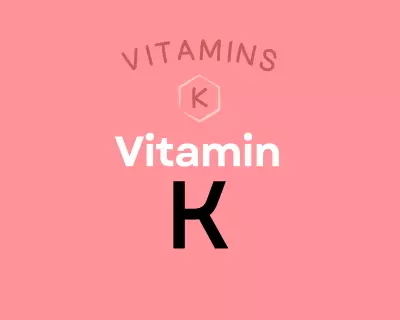
Vitamin K is actually a group of fat-soluble vitamins with a similar molecular structure, existing as K1, multiple isoforms of K2, and the synthetic form K3. This nutrient plays a vital role in coagulation, due to serving as a cofactor for proteins needed for blood clotting; it’s also essential for bone metabolism, cellular function, and the prevention of soft tissue calcification. Getting enough vitamin K2 can help protect against cardiovascular disease, may improve bone mineral density and skeletal health, and may even support endocrine function and brain health; there’s also some limited evidence it has anti-cancer and anti-inflammatory properties. Learn more about vitamin K here.
Want to know the top 500 most nutrient-dense foods?

Top 500 Nutrivore Foods
The Top 500 Nutrivore Foods e-book is an amazing reference deck of the top 500 most nutrient-dense foods according to their Nutrivore Score. Think of it as the go-to resource for a super-nerd, to learn more and better understand which foods stand out, and why!
If you are looking for a quick-reference guide to help enhance your diet with nutrients, and dive into the details of your favorite foods, this book is your one-stop-shop!
Buy now for instant digital access.
How Much Green Onion Should We Eat Per Day?
Not only do members of the allium family (like green onions) offer a unique and irreplaceable flavor for our food, they’re also fantastic for supporting whole-body health!
The health benefits attributed to herbs and spices, and particularly their phytonutrient content and volatile oils, are incredibly vast. In general, herbs and spices have been shown to have powerful antioxidant activity, exhibit anti-cancer effects (especially due to polyphenols, terpenes, vanilloids, and organosulfur compounds), reduce inflammation (for example, basil, bay leaves, sage, thyme, licorice, and oregano have been shown to improve cytokine profiles), and reduce cardiovascular disease risk.
There is evidence from human clinical trials showing that adding spices and herbs to our diet can improve serum lipid profiles (HDL cholesterol, LDL cholesterol and triglycerides) as well as glycemic control, blood pressure, inflammation, and oxidative stress. For example, a 2022 study added a mere 6.6 grams per day per 2100 calories of herbs and spices (that’s about a teaspoon of seasonings throughout the whole day) to the diets of adults with risk factors for cardiovascular disease, with a crossover design comparing to a 3.3 grams of herbs and spices phase as well as a <0.5 grams herbs and spices phase. After four weeks consuming the higher level of herbs and spices, the participants had significant improvements in gut microbiome composition including growth of bacteria associated with reduced cardiovascular disease risk. A 2021 study by the same research group showed reductions in blood pressure after a single day of higher intake of herbs and spices. And a follow-up 2022 study showed reduced markers of inflammation after four weeks of the higher spice intake diet, including reduced fasting plasma IL-6 and postprandial plasma IL-1β, IL-8, and TNF-α. All in all, this makes a compelling case for aiming for a teaspoon of dried herbs and spices (or 1 tablespoon fresh) or more per day added to our meals! Learn more about herbs and spices here.
In addition, studies show that overall consumption of allium vegetables (like green onions), is linked with improved cardiovascular health and lower risk of cancer. In fact, a variety of studies have shown allium vegetable consumption is associated with a lower risk of: colorectal cancer (up to 22% lower risk), endometrial cancer (up to a 24% lower risk; 59% lower risk in premenopausal women), gastric cancer (up to a 46% lower risk), ovarian cancer (up to an 21% lower risk), prostate cancer (up to a 49% lower risk), and upper aerodigestive tract cancer [including oral cavity, pharynx, larynx, & esophagus] (up to a 21% lower risk).
It’s always best to mix up the foods you eat day to day (aiming for a wide variety of different vegetables, fruits, and herbs and spices throughout the week), and green onions definitely have a place at the table.
Easily track your servings of Nutrivore Foundational Foods!

The Nutrivore Weekly Serving Matrix
The Nutrivore Weekly Serving Matrix digital resource is an easy-to-use and flexible weekly checklist designed to help you maximize nutrient-density and meet serving suggestions of Nutrivore foundational foods, all without having to weigh or measure your foods!
Includes a 22-page instructional guide and downloadable interactive guides.
Buy now for instant digital access.
cITATIONS
Expand to see all scientific references for this article.
Beretta HV, Bannoud F, Insani M, Berli F, Hirschegger P, Galmarini CR, Cavagnaro PF. Relationships Between Bioactive Compound Content and the Antiplatelet and Antioxidant Activities of Six Allium Vegetable Species. Food Technol Biotechnol. 2017 Jun;55(2):266-275. doi: 10.17113/ftb.55.02.17.4722. PMID: 28867958; PMCID: PMC5569348.
Clements RS Jr, Darnell B. Myo-inositol content of common foods: development of a high-myo-inositol diet. Am J Clin Nutr. 1980 Sep;33(9):1954-67. doi: 10.1093/ajcn/33.9.1954. PMID: 7416064.
Han JH, Yang YX, Feng MY. Contents of phytosterols in vegetables and fruits commonly consumed in China. Biomed Environ Sci. 2008 Dec;21(6):449-53. doi: 10.1016/S0895-3988(09)60001-5. PMID: 19263798.
Huang Z, Wang B, Eaves DH, Shikany JM, Pace RD. Total phenolics and antioxidant capacity of indigenous vegetables in the southeast United States: Alabama Collaboration for Cardiovascular Equality Project. Int J Food Sci Nutr. 2009 Mar;60(2):100-8. doi: 10.1080/09637480701605715. PMID: 17886092. Forma
USDA Food Central Database: Onions, young green, tops only
Watanabe T, Kioka M, Fukushima A, Morimoto M, Sawamura H. Biotin content table of select foods and biotin intake in Japanese. Int J Anal Bio-Sci. 2014. Vol 2(4):109-125.

